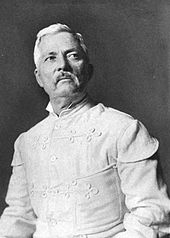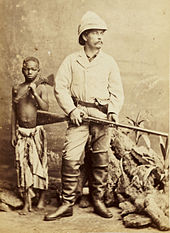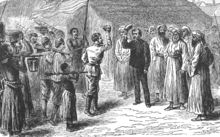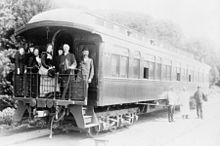
Henry Morton Stanley
Background to the schools Wikipedia
This Schools selection was originally chosen by SOS Children for schools in the developing world without internet access. It is available as a intranet download. Click here for more information on SOS Children.
| Sir Henry Morton Stanley | |
|---|---|
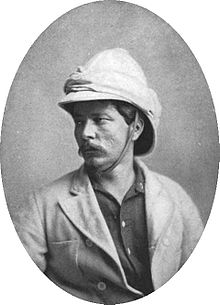 Journalist and explorer |
|
| Born | John Rowlands 28 January 1841 Denbigh, Wales, United Kingdom |
| Died | 10 May 1904 (aged 63) London, United Kingdom |
| Signature | |
Sir Henry Morton Stanley, GCB, born John Rowlands, Kongo byname Bula Matari (“Breaker of Rocks”) (28 January 1841 – 10 May 1904), was a Welsh American journalist and explorer famous for his exploration of central Africa and his search for Scottish missionary and explorer David Livingstone. Upon finding Livingstone, Stanley allegedly uttered the now-famous greeting, "Dr. Livingstone, I presume?" Stanley is also known for his discoveries in and development of the Congo region. He was knighted in 1899.
Early life
When Stanley was born in Denbigh, Denbighshire, Wales, when his mother, Elizabeth Parry, was 19 years old. He never knew his father, who died within a few weeks of his birth; there is some doubt as to his true parentage. His parents were unmarried, so his birth certificate describes him as a bastard and the stigma of illegitimacy weighed heavily upon him all his life.
Originally taking his father's name of Rowlands, Stanley was brought up by his grandfather until the age of five. When his guardian died, Stanley stayed at first with cousins and nieces for a short time, but was eventually sent to St. Asaph Union Workhouse for the poor, where overcrowding and lack of supervision resulted in frequent abuse by the older boys. It has also been postulated that he was raped by the headmaster of the workhouse in 1847. When he was ten, his mother and two siblings stayed for a short while in this workhouse, but Stanley did not recognize them until told by the master about their identities. He stayed until the age of 15. After completing an elementary education, he was employed as a pupil teacher in a National School.
New country, new name
In 1859, at the age of 18, he made his passage to the United States in search of a new life. Upon arriving in New Orleans, he absconded from his boat. According to his own declarations, he became friendly with a wealthy trader named Henry Hope Stanley, by accident: he saw Stanley sitting on a chair outside his store and asked him if he had any job opening for a person such as himself. He did so in the British style: "Do you want a boy, sir?" As it happened, the childless man had indeed been wishing he had a boy of his own, and the inquiry led not only to a job, but to a close relationship. The youth ended up taking Stanley's name. Later, he would write that his adoptive parent had died only two years after their meeting, but in fact the elder Stanley did not die until much later, in 1878. In any case, young Stanley assumed a local accent and began to deny being a foreigner.
Stanley participated reluctantly in the American Civil War, first joining the Confederate Army and fighting in the Battle of Shiloh in 1862. After being taken prisoner he was recruited at Camp Douglas, Illinois by its commander, Col. James A. Mulligan, as a " Galvanized Yankee" and joined the Union Army on 4 June 1862, but was discharged 18 days later due to severe illness. Recovering, he served on several merchant ships before joining the Navy in July 1864. On board the Minnesota he became a record keeper, which led to freelance journalism. Stanley and a junior colleague jumped ship on 10 February 1865 in New Hampshire, in search of greater adventures. Stanley thus became possibly the only man to serve in the Confederate Army, the Union Army, and the Union Navy.
Following the Civil War, Stanley began a career as a journalist. As part of this new career, Stanley organised an expedition to the Ottoman Empire that ended catastrophically when Stanley was imprisoned. He eventually talked his way out of jail and even received restitution for damaged expedition equipment.
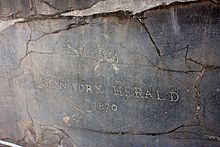
In 1867, Stanley was recruited by Colonel Samuel Forster Tappan (a one-time journalist) of the Indian Peace Commission, to serve as a correspondent to cover the work of the Commission for several newspapers. Stanley was soon retained exclusively by James Gordon Bennett (1795–1872), founder of the New York Herald, who was impressed by Stanley's exploits and by his direct style of writing. He describes this early period of his professional life in Volume I of his book My Early Travels and Adventures in America and Asia (1895). He became one of the Herald's overseas correspondents and, in 1869, was instructed by Bennett's son to find the Scottish missionary and explorer David Livingstone, who was known to be in Africa but had not been heard from for some time. According to Stanley's account, he asked James Gordon Bennett, Jr. (1841–1918), who had succeeded to the paper's management after his father's retirement in 1867, how much he could spend. The reply was "Draw £1,000 now, and when you have gone through that, draw another £1,000, and when that is spent, draw another £1,000, and when you have finished that, draw another £1,000, and so on — BUT FIND LIVINGSTONE!" In actuality, Stanley had lobbied his employer for several years to mount this expedition which presumably would lead to fame and fortune.
Finding Livingstone
Stanley travelled to Zanzibar in March 1871 and outfitted an expedition with the best of everything, requiring no fewer than 200 porters. This 700-mi (1100-km) expedition through the tropical forest became a nightmare. His thoroughbred stallion died within a few days after a bite from a tsetse fly, many of his carriers deserted, and the rest were decimated by tropical diseases. Some recent authors suggest Stanley's treatment of indigenous porters helps to refute his reputation for brutality. However, statements by contemporaries of Stanley, such as Sir Richard Francis Burton, who claimed "Stanley shoots negroes as if they were monkeys", paint a very different picture.
Stanley found Livingstone on 10 November 1871, in Ujiji near Lake Tanganyika in present-day Tanzania, and may have greeted him with the now-famous, " Doctor Livingstone, I presume?" This famous phrase may be a fabrication, as Stanley tore out of his diary the pages relating to the encounter. Even Livingstone's account of the encounter fails to mention these words. However, a summary of Stanley's letters published by The New York Times on 2 July 1872, quotes the phrase. However, Tim Jeal argues in his biography that Stanley invented it afterwards because of his "insecurity about his background".
The Herald's own first account of the meeting, published 4 July 1872, also includes the phrase: "Preserving a calmness of exterior before the Arabs which was hard to simulate as he reached the group, Mr. Stanley said: – "Doctor Livingstone, I presume?" A smile lit up the features of the hale white man as he answered: "Yes, and I feel thankful that I am here to welcome you."
Stanley joined Livingstone in exploring the region, establishing for certain that there was no connection between Lake Tanganyika and the River Nile. On his return, he wrote a book about his experiences: How I Found Livingstone; travels, adventures, and discoveries in Central Africa.
Researching the Congo River
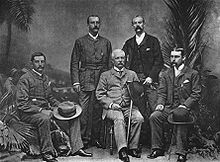
In 1874, the New York Herald, in partnership with Britain's Daily Telegraph, financed Stanley on another expedition to the African continent. One of his missions was to solve a last great mystery of African exploration by tracing the course of the Congo River to the sea. The difficulty of this expedition is hard to overstate. Stanley used sectional boats to pass the great cataracts separating the Congo into distinct tracts. After 999 days, on 9 August 1877, Stanley reached a Portuguese outpost at the mouth of the Congo River. Starting with 356 people, only 114 had survived the expedition, of whom Stanley was the only European.
He wrote about his trials in his book Through the Dark Continent.
Claiming the Congo for the Belgian king
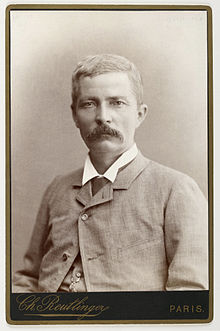
Stanley was approached by the ambitious Belgian king Leopold II, who in 1876 had organised a private holding company disguised as an international scientific and philanthropic association, which he called the International African Society. The king spoke of his intentions to introduce Western civilization and bring religion to that part of Africa, but did not mention he wanted to claim the lands.
At the end of his life, he was embittered by the growing perception that his establishment of a Congo Free State was mitigated by its unscrupulous government; in his defense for having imposed Christian civilization, it was maintained that Stanley had "only been responsible for the death of six or seven hundred negroes....and all these negroes fell as the result of attacking Stanley." In addition, the spread of sleeping sickness across central Africa is attributed to the movements of Stanley's enormous baggage train and the Emin Pasha relief expedition.
In 1886, Stanley led the Emin Pasha Relief Expedition to "rescue" Emin Pasha, the governor of Equatoria in the southern Sudan. King Leopold II demanded that Stanley take the longer route, via the Congo River, hoping to acquire more territory and perhaps even Equatoria. After immense hardships and great loss of life, Stanley met Emin in 1888, charted the Ruwenzori Range and Lake Edward, and emerged from the interior with Emin and his surviving followers at the end of 1890. But this expedition tarnished Stanley's name because of the conduct of the other Europeans: British gentlemen and army officers. An army major was shot by a carrier, after behaving with extreme cruelty. James Jameson, heir to an Irish whiskey manufacturer, bought an 11-year-old girl and offered her to cannibals to document and sketch how she was cooked and eaten. Stanley only found out when Jameson had died of fever.
On his return to Europe, he married Welsh artist Dorothy Tennant, and they adopted a child, Denzil, who in 1954, donated some 300 items to the Stanley archives at the Royal Museum of Central Africa in Tervuren, Belgium. Denzil died in 1959. Stanley entered Parliament as Liberal Unionist member for Lambeth North, serving from 1895 to 1900. He became Sir Henry Morton Stanley when he was made a Knight Grand Cross of the Order of the Bath in 1899, in recognition of his service to the British Empire in Africa.
He died in London on 10 May 1904; at his funeral, he was eulogised by Daniel P. Virmar. His grave, in the churchyard of St. Michael's Church in Pirbright, Surrey, is marked by a large piece of granite inscribed with the words "Henry Morton Stanley, Bula Matari, 1841–1904, Africa". Bula Matari, which translates as "Breaker of Rocks" or "Breakstones" in Kongo, was Stanley's name among locals in Congo. It can be translated as a term of endearment: for as the leader of Leopold's expedition, he commonly worked with the labourers breaking rocks with which they built the first modern road along the Congo River. It can also be translated in far less flattering terms; Adam Hochschild suggested, while Stanley understood it as an heroic epithet, his Congolese companions understood it in a mocking and pejorative tone.
Stanley wrote, in Through the Dark Continent, that "the savage only respects force, power, boldness, and decision." His legacy of death and destruction in the Congo region is considered an inspiration for Joseph Conrad's Heart of Darkness.
Taxa named in honour
Taxa named in honour of Henry Morton Stanley include:
- freshwater snail Gabbiella stanleyi (E. A. Smith, 1877)
- freshwater snail genus Stanleya Bourguignat, 1885
